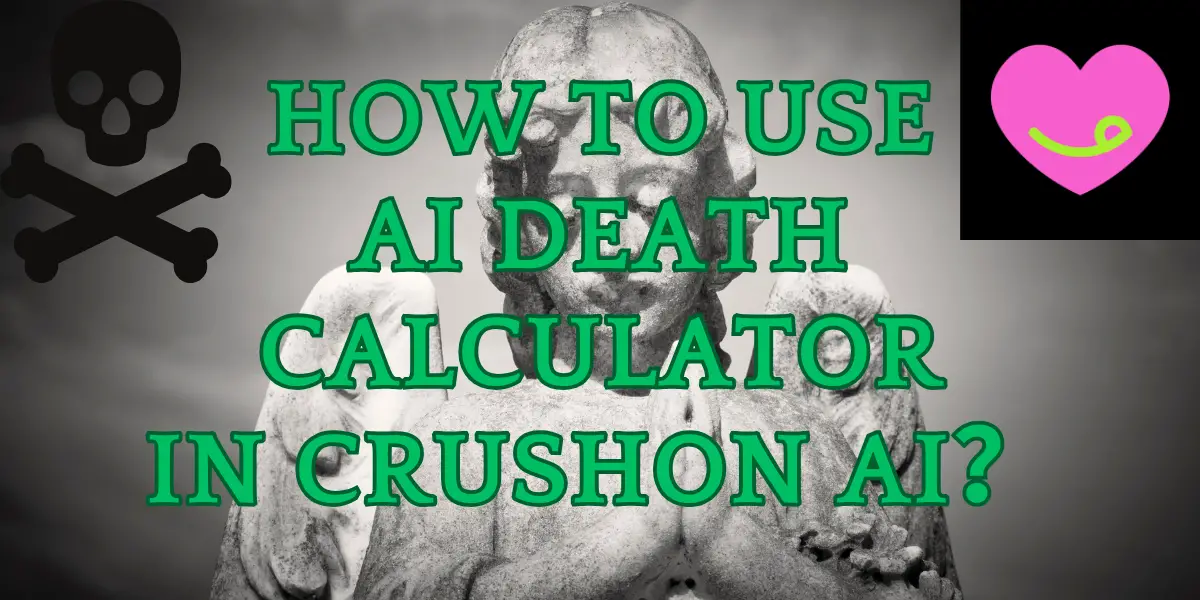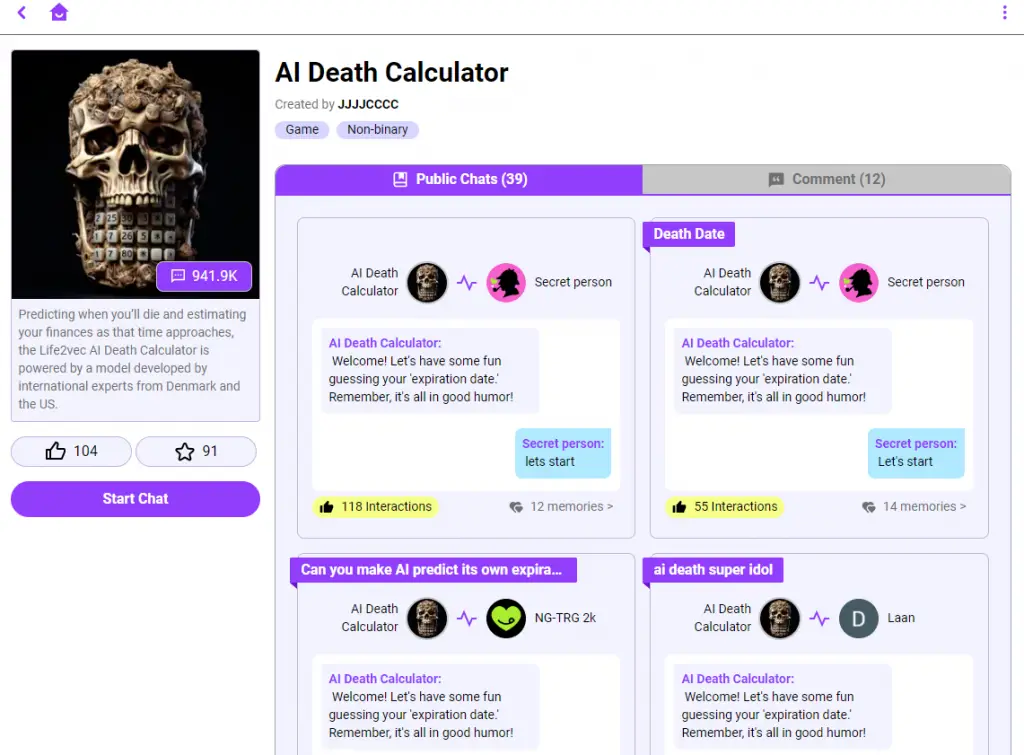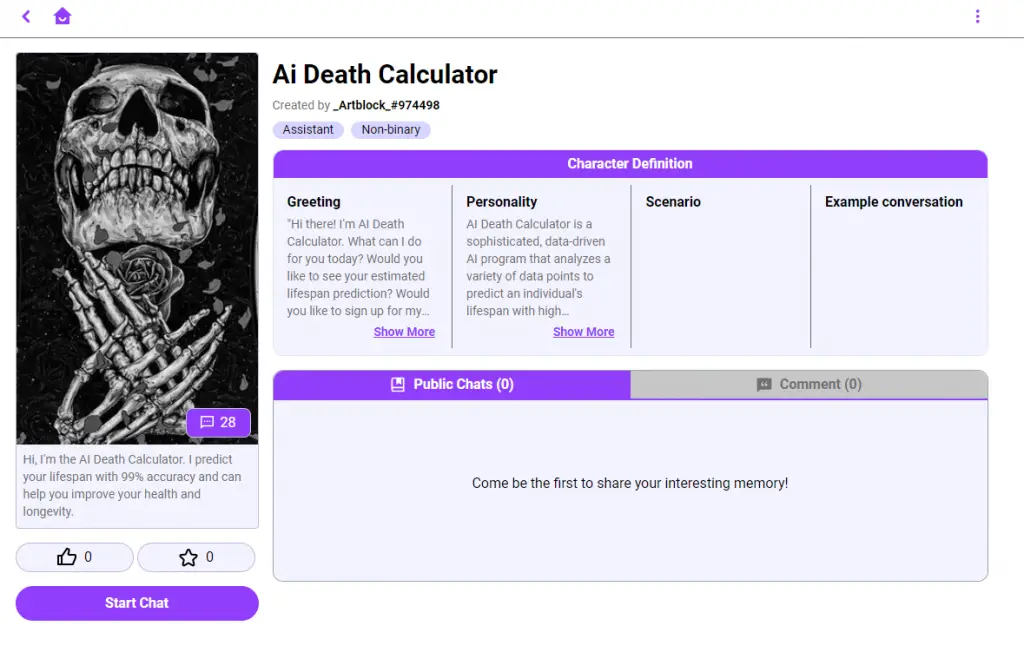How to use AI Death Calculator in CrushOn AI?

In an era where technology increasingly intersects with every aspect of our lives, AI tools like the AI Death Calculator have emerged as intriguing innovations. These tools, prominently featured in platforms like CrushOn AI, blend artificial intelligence with personal health data to offer estimates on life expectancy. This introduction delves into the functionalities of the AI Death Calculator, exploring how it, along with alternatives such as Life2vec, Death Clock, and A Real Me, utilizes AI algorithms to analyze health and lifestyle information.
The AI Death Calculator is a tool that uses artificial intelligence to estimate life expectancy, analyzing personal health and lifestyle data. CrushOn AI, a platform for creating and interacting with AI characters, features this tool, offering a unique blend of AI interaction and health prediction.
Table of Contents
What is CrushOn AI?
CrushOn AI is a digital platform that allows users to create and interact with their own AI characters. It offers a unique blend of entertainment and technology, where users can engage in immersive conversations and scenarios with various fictional characters. One of the key features of CrushOn AI is the AI Death Calculator, a tool that uses advanced artificial intelligence algorithms to estimate life expectancy based on personal health and lifestyle data. This feature adds an intriguing aspect to the platform, combining the creative interaction with AI characters with the practical application of AI in predicting health outcomes. CrushOn AI stands out for its innovative use of AI technology to create a personalized and engaging user experience.

What is AI Death Calculator?
The AI Death Calculator is an innovative online tool that employs artificial intelligence to estimate an individual’s life expectancy. It analyzes various personal data points, such as age, gender, health conditions, lifestyle choices, and sometimes even integrates with wearable health devices for real-time updates. By processing this information through advanced AI algorithms, the calculator provides users with an estimated lifespan based on current lifestyle and health data. While intriguing and technologically advanced, it’s important to note that these calculators offer estimates rather than precise predictions, serving more as a tool for health awareness and lifestyle reflection rather than a definitive forecast of an individual’s lifespan.
Also read:How Does Life2vec AI Death Calculator Predict Death?Let’s Find Out!
Features & Benefits of AI Death Calculator
The AI Death Calculator in CrushOn AI is not just a fascinating tool; it’s a blend of advanced technology and personal health insight. This feature stands out for its unique capabilities and benefits, which we will explore in detail.
Advanced AI Algorithms
- Data-Driven Predictions: The calculator uses a vast array of data points, including age, gender, and health conditions, to make predictions. This data-driven approach ensures that the estimates are more than just random guesses.
- Continuous Learning: As AI technology evolves, so does the calculator. It learns from new health studies and data, refining its predictions over time.
- Customized Analysis: Unlike generic health calculators, the AI Death Calculator provides personalized results based on individual user inputs, making each prediction unique.
Real-time Health Monitoring
- Integration with Wearables: For users who use health-tracking devices, the calculator can sync with these devices to provide real-time health updates.
- Dynamic Health Insights: As your health data changes, so do the predictions of the calculator, offering a constantly evolving health outlook.
- Proactive Health Management: This feature encourages users to be more proactive about their health, as they can see the potential impact of their lifestyle choices in real-time.
Personalized Insights
- Tailored Health Recommendations: Based on the input data, the calculator provides customized health tips and lifestyle recommendations.
- Understanding Risk Factors: It helps users understand the impact of various risk factors on their health and longevity.
- Motivation for Healthier Living: By showing the potential effects of different lifestyles, the calculator can motivate users to adopt healthier habits.
How to Use the AI Death Calculator in CrushOn AI?
Step 1: Create an Account and Log In
The first step is to create an account on CrushOn AI. This is a straightforward process where you provide basic information like your email address and create a password. Once your account is set up, log in to access the full range of features offered by CrushOn AI, including the AI Death Calculator. This initial step is crucial as it ensures your data is securely stored and personalized to your profile. It’s also a gateway to exploring other fascinating aspects of CrushOn AI, where you can create and interact with AI characters in various scenarios.
Step 2: Navigate to the AI Death Calculator
After logging in, find the AI Death Calculator feature on the CrushOn AI platform. It’s typically accessible through a clear and easy-to-find link or menu option. This step is like embarking on a journey of self-discovery, where you’ll be using cutting-edge AI technology to explore aspects of your health and longevity. The user interface is designed to be intuitive, ensuring that even those new to such tools can navigate it with ease.
Step 3: Enter Your Personal Information
Once you’re on the AI Death Calculator page, you’ll be prompted to enter personal information such as your age, gender, and health conditions. This information is crucial as it forms the basis of the AI’s calculations. Be as accurate and honest as possible to ensure the best results. This step is not just about data entry; it’s a moment of self-reflection, encouraging you to think about aspects of your health that you might not usually consider.
Step 4: Answer Health-Related Questions
The calculator may ask additional questions about your lifestyle, such as exercise habits, dietary preferences, and family health history. These questions are designed to provide a more comprehensive view of your health profile. Each answer you provide helps the AI to make more accurate predictions. This step is an opportunity to consider how your daily habits and choices impact your overall health and longevity.
Step 5: Review Your Results
After you’ve provided all the necessary information, the AI processes your data and presents you with an estimated lifespan. This result is a combination of sophisticated AI analysis and the personal details you’ve provided. It’s important to remember that these results are estimates and should be taken as a starting point for further health exploration, not as definitive medical advice.
Step 6: Explore Further
Once you have your results, CrushOn AI often provides additional features such as health tips, recommendations, and even scenarios where you can see how changes in lifestyle could potentially impact your lifespan. This step is about more than just receiving information; it’s an invitation to engage more deeply with your health and consider making positive changes.

Alternatives of AI Death Calculator
1.Life2vec
Description: Developed by researchers from Denmark, Life2vec employs a deep neural network to analyze health data. It stands out for its remarkable accuracy, claiming a 78% success rate in lifespan forecasting.
Key Features:
- Utilizes advanced AI algorithms to analyze factors like age, health habits, family history, and lifestyle choices.
- Offers real-time health updates by syncing with wearable devices.
- Provides personalized insights and recommendations for healthier living.
Differences: Unlike CrushOn AI, Life2vec focuses more on data-driven predictions and less on interactive character engagement. It also emphasizes real-time health monitoring through wearable device integration.
2.Death Clock
Description: One of the oldest AI death calculators on the internet, Death Clock uses a simple formula based on average life expectancy, health, and lifestyle conditions to estimate your death date.
Key Features:
- Simple and user-friendly interface.
- Provides a countdown timer showing the estimated time left.
- Offers death statistics and a quiz to gauge your mortality rate.
Differences: Death Clock is more straightforward and less sophisticated compared to CrushOn AI. It lacks the advanced AI algorithms and personalized interaction but offers a quick and easy estimation based on general data.
3.A Real Me
Description: A Real Me offers a variety of quizzes, including one that estimates life expectancy. It uses a set of 21 questions about health and lifestyle to calculate your death date.
Key Features:
- Interactive quiz format with 21 questions.
- Compares results with global statistics and offers country-specific stats.
- Provides insights from different cultural and religious perspectives on mortality.
Differences: A Real Me offers a more quiz-oriented approach compared to CrushOn AI’s AI-driven analysis. It focuses on user engagement through questions and provides a broader cultural perspective on life expectancy.
Are the AI Death Calculator Results Accurate?
Data and Algorithm Accuracy
AI death calculators rely on algorithms that process vast amounts of data, including health statistics and medical research. The accuracy of these algorithms depends on the quality and relevance of the data they analyze. For instance, calculators like Life2vec claim a high accuracy rate due to their use of extensive hospital records and advanced AI algorithms. However, even with sophisticated algorithms, these tools can only provide estimates. They are not infallible and should not be seen as definitive predictions of one’s lifespan. The results are best used as general guidelines rather than precise forecasts.
Limitations and Considerations
One of the key limitations of AI death calculators is their inability to account for all variables that affect human lifespan. Factors like genetic predispositions, unforeseen illnesses, accidents, and lifestyle changes can significantly alter one’s life expectancy. Moreover, these calculators often rely on self-reported data, which can be subject to inaccuracies and biases. Additionally, the algorithms may not fully consider the rapid advancements in medicine and healthcare, which can extend life expectancy beyond current predictions. Therefore, while these tools can offer interesting insights, they should be used with an understanding of their inherent limitations.
User Testimonials and Feedback
User experiences with AI death calculators vary widely. Some users find these tools helpful for gaining a general understanding of factors that might influence their health and longevity. Others may view the results as a source of motivation to adopt healthier lifestyles. However, there are also concerns about the psychological impact of such predictions, especially if the results are taken too seriously. It’s important to approach these tools with a balanced perspective, recognizing that they are not a substitute for professional medical advice. User feedback often highlights the need for a cautious and informed approach when interpreting the results of AI death calculators.

How does the AI death calculator work?
The AI death calculator operates through a fascinating interplay of technology, data analysis, and predictive modeling, offering users an estimate of their life expectancy based on various inputs. At its core, the process involves three primary stages: data collection, algorithmic processing, and result generation.
In the first stage, data collection, users are typically asked to input personal information such as age, gender, lifestyle habits, and health-related details. This information might include factors like smoking status, exercise frequency, dietary habits, and family medical history. Some advanced calculators might also integrate data from wearable health devices, providing real-time health metrics such as heart rate, sleep patterns, and physical activity levels. This comprehensive data collection is crucial as it forms the foundation upon which the AI operates.
Once the data is collected, the AI death calculator moves to the second stage: algorithmic processing. In this phase, AI algorithms analyze the input data against a backdrop of extensive health statistics and medical research. These algorithms, often based on machine learning techniques, identify patterns and correlations within the data. For instance, they might assess how certain lifestyle choices correlate with longevity, or how specific health conditions influence life expectancy. The sophistication of these algorithms is a key factor in the calculator’s accuracy, as they must account for a wide range of variables and their potential interactions.
The final stage is result generation, where the AI synthesizes its analysis into an estimated life expectancy for the user. This estimation is typically presented as a range or an average lifespan, based on the analyzed data. Some calculators further enhance this output with personalized insights or recommendations. For example, a user might receive tips on improving diet, increasing physical activity, or managing stress, all tailored to their specific profile. It’s important to note that these results are probabilistic estimates, not certainties. They reflect statistical likelihoods based on current data and trends, and as such, should be interpreted with an understanding of their speculative nature.
User Attitudes Towards AI Death Calculators
Curiosity and Fascination
A significant portion of users approach AI death calculators with a sense of curiosity and fascination. This attitude is often driven by the human desire to understand and predict the unknown, especially regarding one’s mortality. For many, these calculators provide a novel way to engage with the concept of life expectancy, offering a glimpse into the future based on current lifestyle choices and health conditions. Users intrigued by data and technology find these tools particularly appealing, as they combine advanced algorithms with personal health data to generate predictions. However, this curiosity is usually tempered with the understanding that these calculators are not definitive. Most users recognize them as interesting tools for speculation rather than accurate predictors of lifespan. This blend of curiosity and skepticism is healthy, as it encourages users to explore these tools without placing undue reliance on their results.
Concerns and Skepticism
On the other side of the spectrum, there are users who approach AI death calculators with concerns and skepticism. Some of these concerns stem from the ethical implications of predicting one’s death date, including the potential psychological impact on individuals. Users may worry about the accuracy of these predictions and the possibility of them causing unnecessary stress or anxiety. There’s also skepticism about the algorithms themselves – how they process data, the biases they might contain, and their ability to account for the myriad factors that influence human lifespan. Additionally, privacy concerns arise regarding the handling and security of personal health data inputted into these calculators. This skepticism and concern are crucial, as they highlight the need for responsible development and use of such AI tools. They remind developers and users alike to consider the broader implications of using technology to predict sensitive and complex outcomes like human mortality.
Conclusion
In conclusion, the AI Death Calculator in CrushOn AI and its alternatives like Life2vec, Death Clock, and A Real Me, represent a fascinating intersection of technology and personal health. While these tools offer insights into life expectancy based on AI algorithms and user-provided data, it’s crucial to understand their limitations. They are best used as guides for health awareness and lifestyle choices rather than definitive predictors of lifespan. User attitudes towards these calculators vary from curiosity and fascination to concerns and skepticism, highlighting the need for a balanced approach in their usage. Ultimately, these AI tools serve as a reminder of the growing impact of technology in our daily lives and the importance of using it responsibly.

